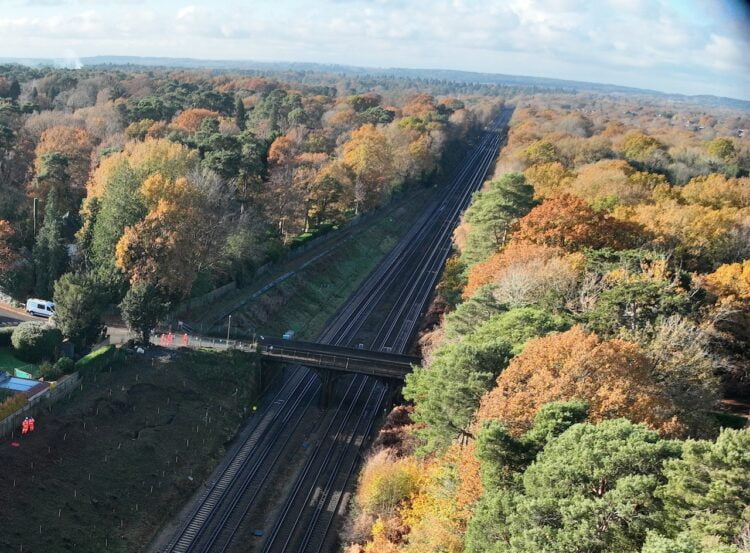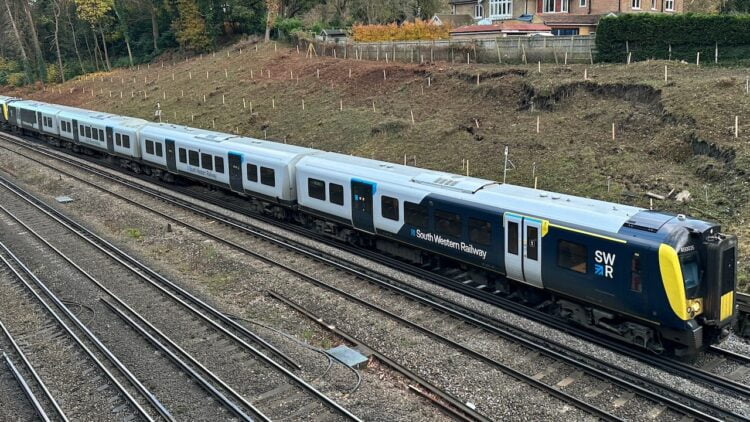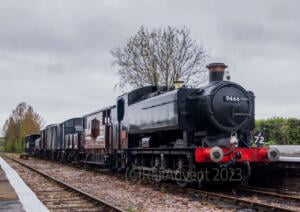Next week will see a significant reduction in services for customers travelling on the railway between Woking and Basingstoke as emergency work takes place to repair a landslip, with travel advice given by both Network Rail and South Western Railway to only travel if completely necessary.
Movement was detected by small sensors which carry out remote condition monitoring, in a 100-metre slope which is located next to St. John’s Hill Road over-bridge between Brookwood and Woking. The monitoring has led Network Rail’s Geotechnical and Structures experts to discover cracks, some of which are up to 45 metres in length with a width of 50cm and up to a metre in depth!
A 20mph speed restriction has been put in place by Network Rail in order to keep trains on the move safely, ahead of the work getting underway.
Network Rail and South Western Railway are working closely together and have elected to close part of the railway next week, which will allow the cutting to be stabilised. The work carried out aims to prevent a landslip in the future which could be dangerous and altogether more disruptive should action not be taken.
Over the coming weekend (2nd & 3rd December) Network Rail will undertake the necessary work to prepare the site, which will involve bringing in specialist equipment and machinery. Work is then set to get underway installing a metal wall starting during the early hours of Monday the 4th of December.

Network Rail engineers will work around the clock from Wednesday the 6th through to and including Sunday the 10th of December to install 170 sheet piles which are 10 metre-long pieces of steel which will be driven into the ground at the base of the slope.
The piles take approximately one hour to install and once complete will stop earth slipping onto the railway. Further sections of cuttings on the line have also been identified as requiring stabilisation, which will take place in the future.
During the period of work, the railway will see its four tracks reduced to two, which means that services will have to be signalled manually by Network Rail engineers using red and green ‘hand signals’ and means that unfortunately, even fewer services will be able to operate.
Train services will be affected as follows:
Wednesday the 6th of December:
- Reduced service levels are set to run due to planned ASLEF strike action and will be unaffected by the work
Thursday the 7th of December:
- South Western Railway’s full service will be affected by an overtime ban by ASLEF – to find out more about this, please click here.
- Friday the 8th to Sunday the 10th of December:
- A substantially reduced rail service will be in operation between Basingstoke and Woking, which will affect routes to Exeter, Salisbury, Southampton, Bournemouth and Weybridge.
- Trains from London Waterloo will not serve Brookwood.
- A rail replacement bus service will operate from Woking to Brookwood.
Customers are advised to visit South Western Railways dedicated Woking Landslip page as well as checking journey planners on Sunday the 3rd of December, when they will be fully updated.

Matt Pocock, Network Rail Wessex route director, said:
“I would like to thank customers and local residents for their patience and understanding over the coming week while our teams work tirelessly to complete emergency work to stabilise this precarious cutting between Woking and Brookwood.”
“There is never a good time to close any part of the railway, but the safety of our customers and railway colleagues is our number one priority. It’s imperative that we act now to prevent any further landslip, which would cause even longer delays.”
“We have worked closely with our colleagues at SWR to identify the least disruptive time to do this and next week provides an opportunity with industrial action, reducing the number of services that will be in operation. However, unfortunately, there will be severely reduced services as a result.”
“Our teams will be working extremely hard to stabilise the embankment as quickly and safely as possible, so we can get customers moving again and prevent any future landslips.”
Stuart Meek, South Western Railway Chief Operating Officer, said:
“We’ve worked closely with our colleagues at Network Rail to ensure that landslip repairs are carried out as quickly as possible while causing the least amount of disruption to our customers.”
“Because engineers will require access to two of the four tracks through the area, with changes to signalling, we will only be able to run three trains an hour in either direction. This is down from the normal 16 trains an hour, on what is one of the busiest parts of the country’s railway network.”
“As a result, we are sorry to have to ask customers intending to travel on our services, between Woking and Basingstoke, to only travel if their journeys are absolutely necessary, on Friday 8, Saturday 9 and Sunday 10 December.”
“We’re very sorry for the disruption. If you must travel, please check using a journey planner or at our website – southwesternrailway.com/plan-my-journey.”






Responses
The ditches atop the cuttings are not being cleared according to my source. The water collects and seeps into the earth and the more the rain the worse the problem gets. We have a road that was once a railway line not far from us, and a couple of years ago a large slip rendered the road impassible for some time. Same problem. Who would’ve thought that the lack of a line meant that proper maintenance had to stop?
Modern management is fire brigade action. Wait until there is a problem then tackle it. Look what happened to Railtrack through lack of maintenance.
Still, today’s management can at least blame global warming!
These train lines have been here for a hundred years. Only recently have all the trees been cut down. The tree roots stabilised the ground.
The railway line has been there since 1838, and tree were not allowed to grow here for approximately 130 years. It’s only since the end of steam that trees have grown on the sides of cuttings and railway embankments.